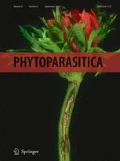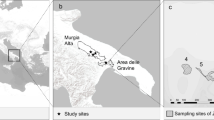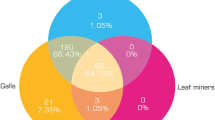Abstract
In insect communities, the outcome of intra- and inter-specific competitions for food utilisation depend primarily upon density and duration even inter-specific competitions can occur when they are not sharing the same feeding niche such as between foliar feeders and stemborers. Experimental manipulations of larval densities and the durations of common diet feeding of fall armyworm (FAW), S. frugiperda, and the African lepidopteran stemborers, Busseola fusca, Sesamia calamistis and Chilo partellus, were conducted to determine how the density and the duration of resource utilization affected larval survival and the relative growth rate (RGR) in intra- and inter-specific interactions. The results showed both intra- and interspecific competitions were observed among all the four species and interspecific competition was significantly stronger between the stemborers than between the FAW and the stemborers. The results showed that multiple infestations of cereal plants with low larval densities of each species at optimum conditions will very likely prolong the coexistence between FAW and stemborers. In addition, the time partitioning of the resource use significantly influenced this coexistence.








Similar content being viewed by others
References
Agrew, P., Hide, M., Sidobre, C., & Michalakis, Y. (2002). A minimalist approach to the effects of density- dependent competition on insect life-history traits. Ecological Entomology, 27, 396–402.
Ayabe, Y., Minoura, T., & Hijii, N. (2015). Plasticity in resource use by the leafminer moth Phyllocnistis Sp. in response to variations in host plant resources over space and time. Journal of Forest Research, 20, 213–221. https://doi.org/10.1007/s10310-014-0467-9
Bentivenha, J. P., Montezano, D., Hunt, T. E., Baldin, E. L., Peterson, J. A., Victor, V., Pannuti, L. E., Velez, A. M., & Paula-Moraes, S. V. (2017). Intraguild interactions and behavior of Spodoptera frugiperda and Helicoverpa spp . on maize. Pest Management Science, 73, 2244–2251. https://doi.org/10.1002/ps.4595
Blanckenhorn, W. U. (1998). Adaptive phenotypic plasticity in growth, development, and body size in the yellow dung fly. Evolution, 52, 1394–1407. https://doi.org/10.1111/j.1558-5646.1998.tb02021.x
Boggs, C. L. (2009). Understanding insect life histories and senescence through a resource allocation lens. Functional Ecology, 23, 27–37. https://doi.org/10.1111/j.1365-2435.2009.01527.x
Bystrom, P., & Garcia-berthou, E. (1999). Density dependent growth and size specific competitive interactions in young fish. Oikos, 86, 217–232.
Calcagno, V., Mouquet, N., Jarne, P., & David, P. (2006). Coexistence in a metacommunity : the competition–colonization trade-off is not dead. Ecology Letters, 9, 897–907. https://doi.org/10.1111/j.1461-0248.2006.00930.x
Cameron, T. C., Wearing, H. J., Rohani, P., & Sait, S. M. (2007). Two-species asymmetric competition : effects of age structure on intra- and interspecific interactions. Journal of Animal Ecology, 76, 83–93. https://doi.org/10.1111/j.1365-2656.2006.01185.x
Chapman, J. W., Williams, T., Escribanoc, A., Caballero, P., & Cave, R. D. (1999a). Fitness consequences of cannibalism in the fall armyworm, Spodoptera frugiperda. Behavioral Ecology, 10, 298–303.
Chapman, J. W., Williams, T., Escribano, A., Caballero, P., Cave, R. D., & Goulson, D. (1999b). Age-related cannibalism and horizontal transmission of a nuclear polyhedrosis virus in larval Spodoptera frugiperda. Ecological Entomology, 24, 268–275.
Chapman, J. W., Williams, T., Martínez, A. M., & Cisneros, J. (2000). Does cannibalism in Spodoptera frugiperda ( Lepidoptera : Noctuidae ) reduce the risk of predation ? Behavioural Ecology and Sociobiology, 48, 321–327. https://doi.org/10.1007/s002650000237
Chesson, P. (2000). Mechanisms of maintenance of species diversity. Annual Review of Ecology and Systematics, 31, 343–366.
Connell, J. H. (1983). On the prevalence and relative importance of interspecific competition: evidence from field experiments. The American Naturalist, 122, 661–696. https://doi.org/10.1086/284165
Coulson, T., Milner-Gulland, E., & Clutton-Brock, T. (2000). The relative roles of density and climatic variation on population dynamics and fecundity rates in three contrasting ungulate species. Proceedings of the Royal Society of London Series B, 267, 1771–1779. https://doi.org/10.1098/rspb.2000.1209
Da Silva, M. (1999). Factors limiting the efficiency of insecticides to control Spodoptera frugiperda Smith in maize. Ciência Rural, 29, 383–387.
Da Silva, C. S. B., & Parra, J. R. P. (2013). New method for rearing Spodoptera frugiperda in laboratory shows that larval cannibalism is not obligatory. Revista Brasileira de Entomologia, 57, 347–349. https://doi.org/10.1590/S0085-56262013005000029
De Polanía, I. Z., Maldonado, H. A., Cruz, R. M., & Sánchez, J. D. (2009). Spodoptera frugiperda: response of different populations to the Cry1Ab toxin. Revista Colombiana de Entomología, 35, 34–41.
Delong, J. P., Hanley, T. C., & Vasseur, D. A. (2014). Competition and the density dependence of metabolic rates. Journal of Animal Ecology, 83, 51–58. https://doi.org/10.1111/1365-2656.12065
Denno, R. F., Mcclure, M. S., & Ott, J. R. (1995). Interspecific interactions in phytophagous insects: Competition Reexamined and Resurrected. Annual Review of Entomology, 40, 297–331 Retrieved from http://jimott.wp.txstate.edu/files/2013/05/1995-Denno-at-al.pdf
Duyck, P. F., David, P., & Quilici, S. (2004). A review of relationships between interspecific competition and invasions in fruit flies (Diptera: Tephritidae). Ecological Entomology, 29, 511–520. https://doi.org/10.1111/j.0307-6946.2004.00638.x
Fantinou, A. A., Perdikis, D. C., & Stamogiannis, N. (2008). Effect of larval crowding on the life history traits of Sesamia nonagrioides (Lepidoptera : Noctuidae). European Journal of Entomology, 105, 625–630. https://doi.org/10.14411/eje.2008.084
Farias, S. P. R., Barbosa, J. C., & Busoli, A. C. (2001). Sequencial sampling based on taylor’s power law for the survey of Spodoptera frugiperda for the corn crop. Scientia Agricola, 58, 395–399.
Flockhart, D. T., Martin, T. G., & Norris, D. R. (2012). Experimental examination of intraspecific density- dependent competition during the breeding period in monarch butterflies (Danaus plexippus). PLoS One, 7, e45080. https://doi.org/10.1371/journal.pone.0045080
Fordyce, J. A. (2006). The evolutionary consequences of ecological interactions mediated through phenotypic plasticity. The Journal of Experimental Biology, 209, 2377–2383. https://doi.org/10.1242/jeb.02271
Gibbs, M., Lace, L. A., Jones, M. J., & Moore, A. J. (2004). Intraspecific competition in the speckled wood butterfly Pararge aegeria : Effect of rearing density and gender on larval life history. Journal of Insect Science, 4, 16.
Goergen, G., Kumar, P. L., Sankung, S. B., Togola, A., & Tamò, M. (2016). First report of outbreaks of the fall armyworm Spodoptera frugiperda (J E Smith) (Lepidoptera, Noctuidae), a new alien invasive pest in West and Central Africa. PLoS One, 11, e0165632.
Goussain, M. M., Moraes, J. C., Carvalho, J. G., Nogueira, N. L., & Rossi, E. M. L. (2002). Effect of silicon application on corn plants upon the biological development of the fall Armyworm Spodoptera frugiperda (J.E. Smith) (Lepidoptera: Noctuidae). Neotropical Entomology, 31, 305–310.
Gurevitch, J., Morrow, L. L., Wallace, A., & Walsh, J. S. (1992). A Meta-analysis of competition in field experiments. The American Naturalist, 140, 539–572.
Hailu, G., Niassy, S., Bässler, T., Ochatum, N., Studer, C., Salifu, D., Agbodzavu, M. K., Khan, Z. R., Midega, C., & Subramanian, S. (2021). Could fall armyworm, Spodoptera frugiperda (J. E. Smith) invasion in Africa contribute to the displacement of cereal stemborers in maize and sorghum cropping systems. International Journal of Tropical Insect Science, 41, 1753–1762. https://doi.org/10.1007/s42690-020-00381-8
Hemphill, N. (1991). Disturbance and variation in competition between two stream insects. Ecology, 72, 864–872.
Inbar, M. (1995). Interspecific competition among phloem-feeding insects mediated by induced host-plant sinksi. Ecology, 76, 1506–1515.
Kaplan, I., & Denno, R. F. (2007). Interspecific interactions in phytophagous insects revisited: A quantitative assessment of competition theory. Ecology Letters, 10, 977–994. https://doi.org/10.1111/j.1461-0248.2007.01093.x
Kfir, R. (1997). Competitive displacement of Busseola fusca (Lepidoptera: Noctuidae) by Chilo partellus (Lepidoptera: Pyralidae). Annals of the Entomological Society of America, 90, 619–624. https://doi.org/10.1093/aesa/90.5.619
Kfir, R., Overholt, W. A., Khan, Z. R., & Polaszek, A. (2002). Biology and management of economicaly important lepidopteran cereal stem borers in Africa. Annual Review of Entomology, 47, 701–731. https://doi.org/10.1146/annurev.ento.47.091201.145254
Khadioli, N., Tonnang, Z. E. H., Muchugu, E., Ong’amo, G., Achia, T., Kipchirchir, I., Kroschel, J., & Le Ru, B. (2014a). Effect of temperature on the phenology of Chilo partellus ( Swinhoe ) ( Lepidoptera , Crambidae); simulation and visualization of the potential future distribution of C . partellus in Africa under warmer temperatures through the development of life-table. Bulletin of Entomological Research, 104, 809–822. https://doi.org/10.1017/S0007485314000601
Khadioli, N., Tonnang, Z. E. H., Ong’mo, G., Achia, T., Kipchirchir, I., Kroschel, J., & Le Ru, B. (2014b). Effect of temperature on the life history parameters of noctuid lepidopteran stem borers , Busseola fusca and Sesamia calamistis. Annals of Applied Biology, 165, 373–386. https://doi.org/10.1111/aab.12157
King, E. G., & Roff, D. A. (2010). Modeling the evolution of phenotypic plasticity in resource allocation in wing-dimorphic insects. The American Naturalist, 175, 702–716. https://doi.org/10.1086/652434
Krüger, W., van den Berg, J., & van Hamburg, H. (2008). The relative abundance of maize stem borers and their parasitoids at the Tshiombo irrigation scheme in Venda, South Africa. South African Journal of Plant and Soil, 25, 144–151. https://doi.org/10.1080/02571862.2008.10639910
Leisnham, S. A., & Juliano, P. T. (2009). Spatial and temporal patterns of coexistence between competing Aedes mosquitoes in urban Florida. Oecologia, 160, 343–352. https://doi.org/10.1007/s00442-009-1305-1
Lenth, R. V. (2016). Least-Squares Means : The R Package lsmeans. Journal of Statistical Software, 69, 1–33.
Miner, B. G., Sultan, S. E., Morgan, S. G., Padilla, D. K., & Relyea, R. A. (2005). Ecological consequences of phenotypic plasticity. Trends in Ecology & Evolution, 20, 685–692. https://doi.org/10.1016/j.tree.2005.08.002
Muriu, S. M., Coulson, T., Mbogo, C. M., & Godfray, H. C. J. (2013). Larval density dependence in Anopheles gambiae s. s., the major African vector of malaria. Journal of Animal Ecology, 82, 166–174. https://doi.org/10.1111/1365-2656.12002
Ntiri, E. S., Calatayud, P. A., Van Den Berg, J., Schulthess, F., & Le Ru, B. P. (2016). Influence of temperature on intra- And interspecific resource utilization within a community of lepidopteran maize stemborers. PLoS One, 11, e148735. https://doi.org/10.1371/journal.pone.0148735
Ntiri, E. S., Calatayud, P. A., Van den Berg, J., & Le Ru, B. P. (2017). Density dependence and temporal plasticity of competitive interactions during utilisation of resources by a community of lepidopteran stemborer species. Entomologia Experimentalis et Applicata, 162, 272–283. https://doi.org/10.1111/eea.12514
Nylin, S., & Gotthard, K. (1998). Plasticity in Life-History Traits. Annual Review of Entomology, 43, 63–83. https://doi.org/10.1146/annurev.ento.43.1.63
Ojeda-Avila, T., Woods, H. A., & Raguso, R. A. (2003). Effects of dietary variation on growth , composition , and maturation of Manduca sexta (Sphingidae : Lepidoptera). Journal of Insect Physiology, 49, 293–306. https://doi.org/10.1016/S0022-1910(03)00003-9
Ong’amo, G., Le Rü, B., Dupas, S., Moyal, P., Calatayud, P.-A., & Silvain, J.-F. (2006). Distribution, pest status and agro-climatic preferences of lepidopteran stem borers of maize in Kenya. Annales de La Société Entomologique de France (N.S.), 42, 171–177. https://doi.org/10.1080/00379271.2006.10700620
Onyango, F. O., & Ochieng’-Odero, J. E. R. (1994). Continuous rearing of the maize stem borer Busseola fusca on an artificial diet. Entomologia Experimentalis et Applicata, 73, 139–144.
R Core Team. (2018). R: A language and environment for statistical computing. R Foundation for Statistical Computing Retrieved from https://www.R-project.org/
Rebe, M., van den Berg, J., & Mcgeoch, M. A. (2004). Colonization of cultivated and indigenous graminaceous host plants by Busseola fusca (Fuller) (Lepidoptera: Noctuidae) and Chilo partellus (Swinhoe) (Lepidoptera: Crambidae) under field conditions. African Entomology, 12, 187–199.
Rwomushana, I., Bateman, M., Beale, T., Beseh, P., Cameron, K., Chiluba, M., Clottey, V., Davis, T., Day, R., Early, R., Godwin, J., Gonzalez-Moreno, P., Kansiime, M., Kenis, M., Makale, F., Mugambi, I., Murphy, S., Nunda, W., Phiri, N., et al. (2018). Fall armyworm: Impacts and implications for Africa. In Evidence Note Update, October 2018. CABI.
Sarmento, R. D. A., Aguiar, D. S. W. R., Aguiar, R. D. A. S. d. S., Viera, S. M. J., de Oliveira, H. G., & Holtz, A. M. (2002). Biology review, occurence and control of Spodoptera frugiperda Smith (Lepidoptera: Noctuidae) in corn in Brazil. Bioscience Journal, 18, 41–48.
Schoener, T. W. (1983). Field experiments on interspecific competition. The American Naturalist, 122, 240–285. https://doi.org/10.1086/284133
Seshu Reddy, K. V. (1998). Maize and sorghum: East Africa. In A. Polaszek (Ed.), African cereal stem borers: economic importance, taxonomy, natural enemies and control. CAB International. Wallingford.
Sisay, B., Simiyu, J., Malusi, P., Likhayo, P., Mendesil, E., Elibariki, N., Wakgar, M., Ayalew, G., & Tefera, T. (2018). First report of the fall armyworm, Spodoptera frugiperda (Lepidoptera: Noctuidae), natural enemies from Africa. Journal of Applied Entomology, 142, 800–804. https://doi.org/10.1111/jen.12534
Sokame, B. M., Rebaudo, F., Malusi, P., Subramanian, S., Kilalo, D. C., Juma, G., & Calatayud, P.-A. (2020). Influence of temperature on the interaction for resource utilization between Fall Armyworm, Spodoptera frugiperda (Lepidoptera : Noctuidae), and a community of lepidopteran maize stemborers larvae. Insects, 11, 73.
Sokame, B. M., Musyoka, B., Obonyo, J., Rebaudo, F., Abdel-rahman, E. M., Subramanian, S., Kilalo, D. C., Juma, G., & Calatayud, P.-A. (2021). Impact of an exotic invasive pest, Spodoptera frugiperda (Lepidoptera : Noctuidae), on resident communities of pest and natural enemies in maize fields in Kenya. Agronomy, 11, 1074. https://doi.org/10.3390/agronomy11061074
Svensson, E., Sinervo, B., & Comendant, T. (2001). Density-dependent competition and selection on immune function in genetic lizard morphs. Proceedings of the National Academy of Sciences of the USA, 98, 12561–12565.
Tardy, O., Masse, A., Pelletier, F., Mainguy, J., & Fortin, D. (2014). Density-dependent functional responses in habitat selection by two hosts of the raccoon rabies virus variant. Ecosphere, 5, 132. https://doi.org/10.1890/ES14-00197.1
Tefera, T. (2004). Lepidopterous stem borers of sorghum and their natural enemies in eastern Ethiopia. Tropical Science, 44, 128–130. https://doi.org/10.1002/ts.153
Teng, H., & Apperson, C. S. (2000). Development and survival of immature Aedes albopictus and Aedes triseriatus (Diptera : Culicidae ) in the laboratory : Effects of density, food and competition on response to temperature. Journal of Medical Entomology, 37, 40–52. https://doi.org/10.1603/0022-2585-37.1.40
Tilman, D. (1982). Resource competition and community structure. Monogr. Pop. Biol, 17 Princeton University Press, Princeton, N.J. 296p.
Underwood, N. (2010). Density dependence in insect performance within individual plants : Induced resistance to Spodoptera exigua in tomato. Oikos, 119, 1993–1999. https://doi.org/10.1111/j.1600-0706.2010.18578.x
Van den Berg, J., Van Rensburg, J. B. J., & Pringle, K. L. (1991). Comparative injuriousness of Busseola fusca (Lepidoptera: Noctuidae) and Chilo partellus (Lepidoptera: Pyralidae) on grain sorghum. Bulletin of Entomological Research, 81, 137–142. https://doi.org/10.1017/S0007485300051191
Van Hamburg, H. (1980). The grain-sorghum stalk-borer, Chilo partellus (Swinhoe) (Lepidoptera: Pyralidae): survival and location of larvae at different infestation levels in plants of different ages. Journal of the Entomological Society of Southern Africa, 43, 71–76.
Van Hamburg, H., & Hassel, M. (1984). Density dependence and the augmentative release of egg parasitoids against graminaceous stalkborers. Ecological Entomology, 9, 101–108.
Verhoeven, K. J. F., Simonsen, K. L., & McIntyre, L. M. (2005). Implementing false discovery rate control: Increasing your power. Oikos, 108, 643–647.
Werner, E. E., & Gilliam, J. F. (1984). The ontogenetic niche and species interactions in size-structured populations. Annual Review of Ecology and Systematics, 15, 393–425. https://doi.org/10.1146/annurev.es.15.110184.002141
Wissinger, S. A. (1989). Seasonal variation in the intensity of competition and predation among dragonfly larvae. Ecology, 70, 1017–1027. https://doi.org/10.2307/1941370
Acknowledgements
The authors wish to thank the German Academic Exchange Service (DAAD) for funding the PhD fellowship under the grant number 91636630, and the University of Nairobi and icipe Capacity Building Program (ARPPIS) for hosting the PhD student. This research was funded by the ‘Institut de Recherche pour le Développement’ (IRD)-France through the IRD Collaborative Research project (grant number B4405B) and the integrated pest management strategy to counter the threat of invasive fall armyworm to food security in eastern Africa (FAW-IPM) (grant number DCI-FOOD/2017/) financed through the European Union. We also acknowledge the financial support for this research by the following organizations and agencies: the UK’s Department for International Development (DFID), the Swedish International Development Cooperation Agency (SIDA), the Swiss Agency for Development and Cooperation (SDC), and the Kenyan Government. Thanks are also due to the stemborer rearing unit at the ARCU-icipe, especially to Josphat Akhobe and John Buluma, for rearing and supplying insect larvae and artificial diets. Thanks also to Fritz Schulthess for his critical review of the manuscript and his English correction.
Author information
Authors and Affiliations
Corresponding author
Ethics declarations
Conflict of interest
The authors declare that they have no conflicts of interest.
Additional information
Publisher’s note
Springer Nature remains neutral with regard to jurisdictional claims in published maps and institutional affiliations.
Supplementary Information
ESM 1
(DOCX 48 kb)
Rights and permissions
About this article
Cite this article
Sokame, B.M., Malusi, P., Subramanian, S. et al. Do the invasive Fall Armyworm, Spodoptera frugiperda (Lepidoptera: Noctuidae), and the maize lepidopteran stemborers compete when sharing the same food?. Phytoparasitica 50, 21–34 (2022). https://doi.org/10.1007/s12600-021-00952-6
Received:
Accepted:
Published:
Issue Date:
DOI: https://doi.org/10.1007/s12600-021-00952-6




